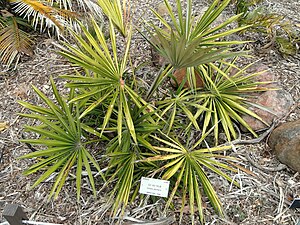Guihaia
| Guihaia | ||||||||||||
|---|---|---|---|---|---|---|---|---|---|---|---|---|

Guihaia argyrata |
||||||||||||
| Systematics | ||||||||||||
|
||||||||||||
| Scientific name | ||||||||||||
| Guihaia | ||||||||||||
| J.Dransf. , SKLee & FNWei |
Guihaia is a genus of palm that is native to China and Vietnam. The species of the genus are rarely cultivated as ornamental plants, but otherwise not used.
features
The representatives are dwarf, more or less trunkless fan palms . They are multi-stemmed, unreinforced or reinforced, flowering several times and dioeciously separated sexes ( diocesan ). The trunk is prostrate or upright, very short and covered with the perennial petiole bases and leaf sheaths .
The chromosome number is 2n = 36.
leaves
The leaves are reduplicated, fan-shaped and dry up on the plant (marzescence). The leaf sheaths disintegrate into a mass of interwoven, coarse, black, spike-like fibers or into a tongue-shaped network of coarse, flat fibers. The petiole is moderately long, unarmed, with sharp edges and woolly hairy. The hastula on the top is rounded, glabrous or covered with woolly hair. The leaf blade is circular or wedge-shaped. It is divided over 3/4 to 4/5 of the radius into around 20 linear, single or rarely double reduplicat folded segments. The edges of the segments are serrated or smooth. The top of the blade is dark green and glabrous with the exception of scales along the leaf veins. The underside is densely covered with silver woolly hair or bald.
Inflorescences
The inflorescences are individually in the leaf axils and between the leaves. They are branched up to four times. Male and female inflorescences are similar. The cover sheet is long, tubular, two-keeled, thin and somewhat leathery. At the top it tears on two sides. The peduncle is long, slightly flattened and has no bracts. The inflorescence axis carries two to five bracts, which are similar to the cover sheet, but are not two-keeled. There are four to five first-order side branches. The flower-bearing side axes (rachillae) are protruding, few to numerous, very slender and straight. They have single flowers on small swellings in a spiral arrangement.
blossoms
The male flowers are very small and symmetrical. The three sepals are only briefly fused at the base, otherwise free. They are round to oval, the outside is hairy and fringed with woolly hair. The petals are longer than the sepals and a third to half fused. The corolla lobes are rounded and bald. There are six stamens , the filaments of which do not form a tube, but are completely fused with the crown. The anthers are rounded and appear to arise directly from the crown. One stamp rudiment is missing. The pollen is ellipsoidal, bisymmetrical to slightly asymmetrical and measures 17 to 24 µm on the longest axis.
The female flowers are similar to the male flowers, but are slightly more rounded. The sepals resemble those of the male flowers. The length of the petals ranges from a little longer than to twice as long as the sepals. They are connected to one another in the lower third. There are six staminodes that sit directly on the petals. The three carpels are free bare and at the upper end abruptly in a short stylus narrowed. The ovule sits basal.
Fruits and seeds
The fruit only develops from a carpel. It is round to ellipsoidal, blue-black in color and has a thin, white layer of wax. The scar remnants are apical, the undeveloped fruit leaf remnants basal. The exocarp is bare, the mesocarp very thin and fleshy, the endocarp paper. The seed is flattened on one side, has a lateral umbilicus (hilum) and a clearly pronounced ingrowth of the integument. The endosperm is homogeneous. The embryo sits laterally.
Distribution and locations
Guihaia argyrata is endemic to southern China ( Guangxi and Guangdong ), Guihaia grossifibrosa in northern Vietnam and southwest Guangxi. Both species occur only on the steep slopes and in the crevices of the karst hill country, where they only rise to around 200 m above sea level. They grow in warm-temperate to subtropical climates up to about 26 ° north latitude.
Systematics
The genus Guihaia J.Dransf., SKLee & FNWei is placed within the family Arecaceae in the subfamily Coryphoideae , Tribus Trachycarpeae , Subtribus Rhapidinae . The monophyly of the genus has not yet been investigated. Their sister group is Rhapis or Trachycarpus , depending on the examination .
The Royal Botanic Gardens, Kew's World Checklist of Selected Plant Families recognizes the following species:
- Guihaia argyrata (SKLee & FNWei) SKLee, FNWei & J.Dransf. ( Type species ): China to northeast Vietnam
- Guihaia grossifibrosa (Gagnep.) J.Dransf., SKLee & FNWei : China to northern Vietnam
- Guihaia heterosquama Xian Y.Li : She wasfirst describedin 2019 from Chongqing .
- Guihaia lancifolia K.W.Luo & FWXing : It wasfirst describedin 2017 from Guangxi .
supporting documents
- John Dransfield, Natalie W. Uhl, Conny B. Asmussen, William J. Baker, Madeline M. Harley, Carl E. Lewis: Genera Palmarum. The Evolution and Classification of Palms . Second edition, Royal Botanic Gardens, Kew 2008, ISBN 978-1-84246-182-2 , pp. 249-251.
Individual evidence
- ↑ a b c Rafaël Govaerts (Ed.): Guihaia. In: World Checklist of Selected Plant Families (WCSP) - The Board of Trustees of the Royal Botanic Gardens, Kew . Retrieved April 15, 2020.
Web links
- Guihaia on the homepage of the Fairchild Tropical Botanic Garden